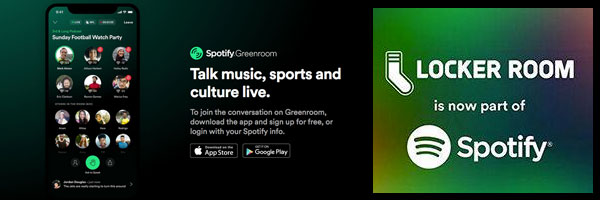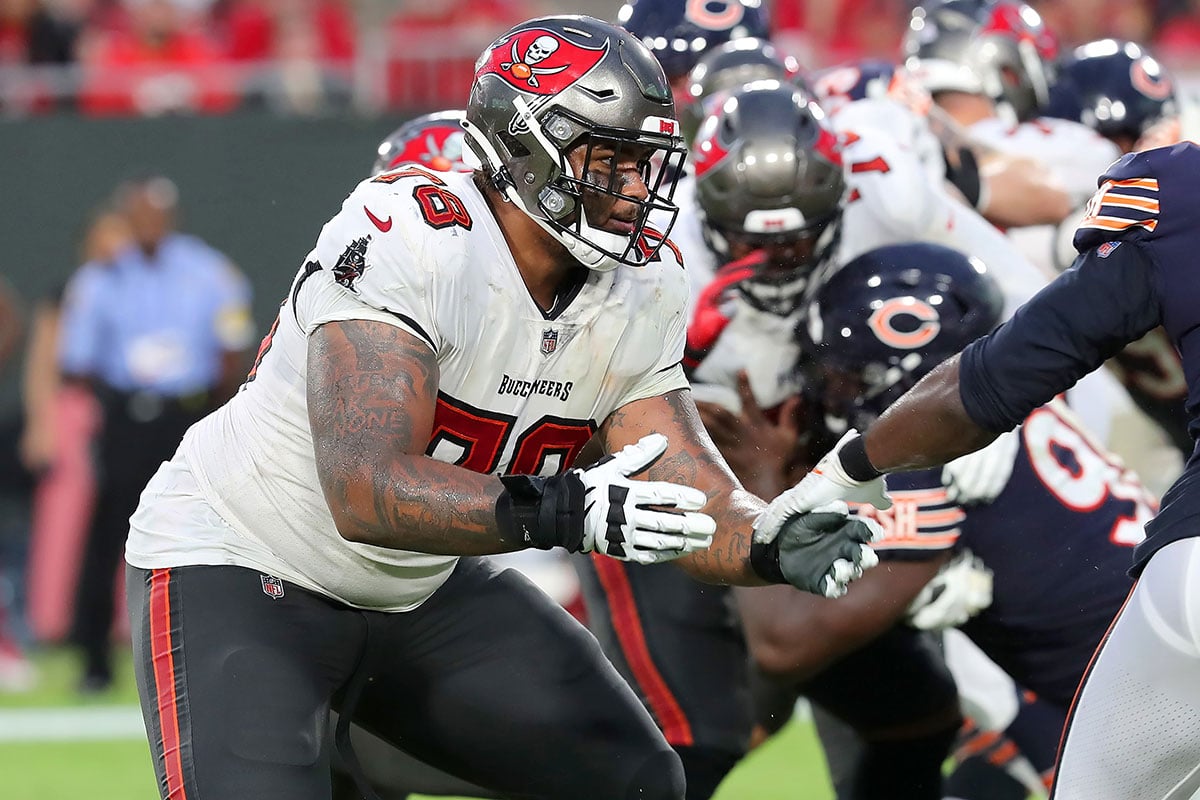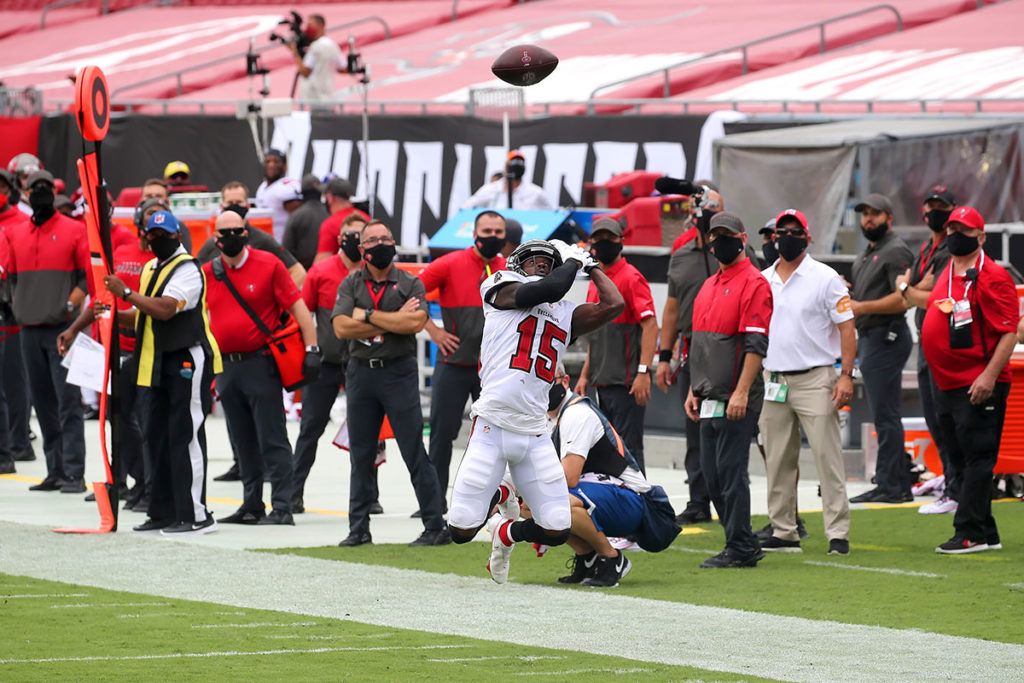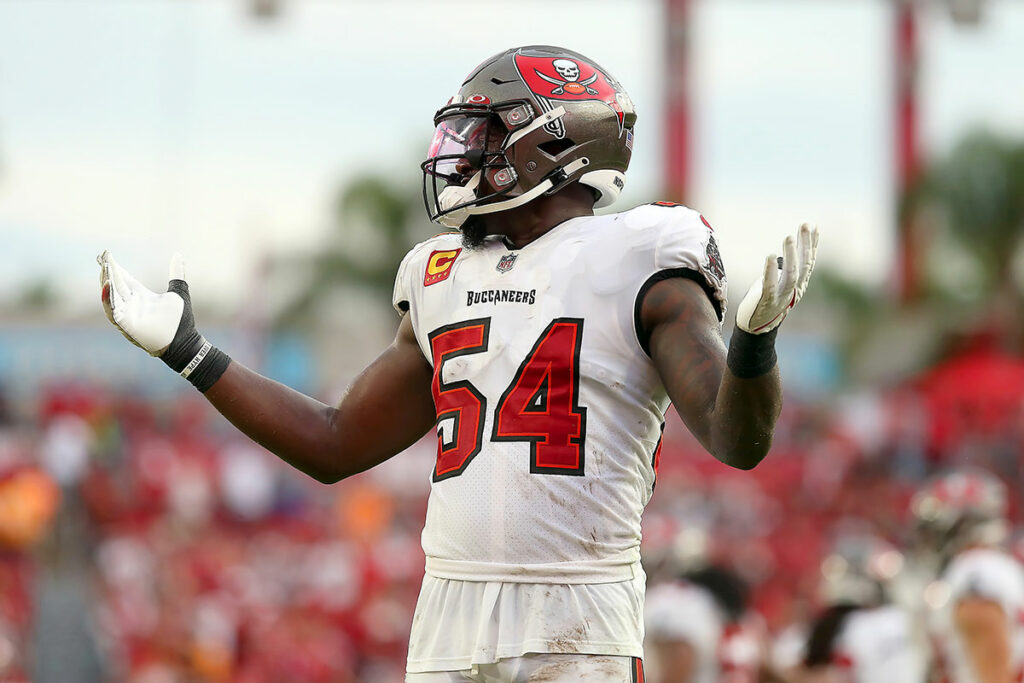
Bucs Briefing is exclusively sponsored by Spotify Green Room: Tap In, Talk Sports – the official social audio partner of PewterReport.com.
Spotify Green Room is changing the way we talk sports (and talk about the Bucs!). It’s the only place for live audio conversations about the takes, rumors, news, and teams you care about.
React to sports news as it happens. Gather all your friends in watch parties for the biggest games. Rep your favorite teams and find your community. Better sports talk is just a tap away — download on the Apple App Store and join the conversation!
Welcome to the in-season edition of Bucs Briefing! My weekly column will appear each Wednesday morning, typically detailing seven key observations from the team’s most recent game. We’ll look at tape, scheme and major storylines as we get ready to close the door on one game, and open the door on the next. Enjoy!
7. Wirfs Dominated Rematch With Mack
I pulled up the tape of Tristan Wirfs vs Khalil Mack, expected to see a back-and-forth affair. Instead, what I got was a completely one-sided display of dominance from Wirfs.
These are just a few of the dominant reps from Wirfs, who decisively won every snap against Mack on Sunday. The former first-rounder was dominant, showing outstanding technique and footwork against a variety of rushes. Wirfs was highly aggressive too, often landing the first strike and stymieing Mack’s hand usage, his best asset. It was clearly a personal match-up for Wirfs, and the results were squarely in his favor.
I was going to break down every rep, but this series of clips from Brian Baldinger shows everything up close. Brilliant stuff.
https://twitter.com/BaldyNFL/status/1453086648196026369?s=20
Up next, a rematch with Cam Jordan and Marcus Davenport for a Saints defensive front that is getting healthy and dangerous. The road ahead isn’t easy for Wirfs based on the match-ups on the schedule, but he’s proven equal to every task in his career so far.
6. Bucs Run Scheme Evolution: Outside Zone
As many of you know, the Bucs have traditionally been a Duo-heavy run scheme, with lots of double teams and a primarily interior attack between the tackles. Occasionally the Bucs dabbled in inside zone and split zone concepts, even throwing in the rare crack toss last season. But in 2021, we’re seeing a much more diverse run scheme, which is challenging the way defenses defend Tampa Bay.
In the offseason, it was crucial that Tampa Bay find more efficient ways to run the football if teams were going to keep two deep safeties against Tom Brady and Co. Seven weeks into the season, it seems Byron Leftwich and Bruce Arians have found some answers. The Bucs are running outside zone at a much higher rate over the past month, which has been key to their success on the ground.
Good job by left tackle Donovan Smith here, helping left guard Ali Marpet secure the slanting defensive end before getting downfield to eliminate inside linebacker Roquan Smith. And a great job by running back Leonard Fournette to take a step or two inside, which caused Roquan Smith to hesitate and allowed Donovan Smith to get a better angle for the block. Lots of variables in the run game, and more you can eliminate, the better chance you have at success. That’s a huge benefit to being able to run at C and D gaps, it basically eliminates half the defense.
Look at Marpet’s athleticism on the play above, chipping defensive tackle Javon Hargrave and posting him for center Ryan Jensen to handle than leaving to head to the linebacker level where he has the quickness to find a target in linebacker Davion Taylor, reach him, and pave the way for Fournette’s run to the outside.
It makes complete sense that Tampa Bay would be a good outside zone rushing team, the Bucs just never really focused on it before. Nothing is going to replace their duo roots, but being able to switch gears and give opposing defensive fronts much more to game plan for is a big deal. Becoming a threatening run game outside of the box has made the Bucs more dangerous and efficient when they do run the football.
5. Bucs Run Scheme Evolution: Split Zone
The outside zone approach has also allowed the Bucs to slip some of their split zone stuff back into the game plan. Get the linebackers reading the zone flow, then hit it backside into a clear alley. This also creates easier blocks for the Bucs tight ends, unlike duo which often leaves them one-on-one with a defensive end.
On the Bucs’ second run of the game, the Bears load the line of scrimmage to match Tampa Bay’s jumbo look with Josh Wells as a tight end. But Chicago maintains two-high safeties, until Chris Godwin motions into the box. Bears safety Eddie Jackson rolls down, but instead of blocking, Godwin releases to the flat on a route. He even throws up his hand and calls for the ball, drawing Jackson’s attention.
So the Bucs remove a defender from run support without actually blocking him due to Godwin’s release, making Roquan Smith the lone second level defender. The Bucs O-line can’t get a hat on him, but Smith is looking for an inside run that never comes. Fournette sneaks out the backside behind an easy kick out block from O.J. Howard, and it’s free access to the secondary. You don’t have to be a great runner when the scheme and blocking are on point.
Later in the game, the Bucs did it again, this time out of 13 personnel with seven offensive linemen on the field. Roquan Smith is reading out his keys, and Donovan Smith is able to seal him inside to secure the second level. Cam Brate does enough to get in the way on the kick block, and Ronald Jones II is off and running.
Not every team will stay with two deep safeties against the Bucs’ 13 personnel packages, but when they do, Tampa Bay has to be able to gash the opponent. Not every team is going to load the line of scrimmage, anticipating the Bucs to run Duo. But when they do, Tampa Bay needs to have outside zone and split zone counters to take advantage of light second level counts. Last year the team couldn’t, and it was a big problem. This year, the Bucs are better suited to create offense on the ground when they need to. It’ll always be a pass-first offense, and it should be. But greater efficiency in the run game has been a huge asset this season.
4. Vaughn Impresses In 2021 Debut
Ke’Shawn Vaughn played his first offensive snaps of the 2021 season on Sunday, and the results were encouraging. Running behind the Bucs starting offensive line, Vaughn showed creativity, burst and some tackle-breaking ability. Of course, we are talking about just five carries for 27 yards (5.1 avg.), but it was nice to see improvement.
Good vision and improvisation by Ke’Shawn Vaughn. Yelder gets blown up, and Jensen and Cappa are obliterating the shade, so he slips out the backside and breaks a tackle pic.twitter.com/RwtPigcauy
— Jon Ledyard (@LedyardNFLDraft) October 26, 2021
On this play, Vaughn’s initial path is stopped when tight end Deon Yelder is blown up at the line of scrimmage. But Vaughn keeps his eyes scanning and improvises, finding a backside lane where Jensen and Cappa have obliterated the nose tackle. As he works downfield, Vaughn is able to wriggle out of a diving tackle attempt and pick up a few extra yards.
An awesome block by Jensen makes this run possible, but watch Vaughn’s acceleration and how it leads to broken tackles. Because he plays so fast on this run, defenders are forced to make tackles from the side, which he can more easily absorb without breaking stride. Great finish on this 15-yard run.
We saw just 11 snaps from Vaughn, but even on his smaller gains he made something out of nothing. It was a small sample size, but encouraging nonetheless. With Fournette, Jones and Giovani Bernard all free agents after this year, Vaughn will have a bigger role next season. One or two of those guys could be back, but Vaughn’s development could secure a place in the Bucs’ future plans at the position.
3. Main Culprit In Bucs’ Leaky Run Defense
Tampa Bay has given up 161 rushing yards to opposing running backs over the past two games. That’s far more than the team’s typical effort, which begs the question: what is the problem? With the Saints up next on the schedule, the Bucs better figure out their run defense issues quickly. The good news is that the problem is pretty easily isolated. Its’ name is Devin White.
Against the Eagles, Philadelphia really didn’t find much running room early. But when the Bucs started presenting lighter boxes, the Eagles responded by running it more. I have no issue with allowing more yards than usual on the ground in a game where the Bucs had a big lead, but this kind of stuff still can’t happen.
Jason Kelce taking Devin White for a ride 20 yards downfield @BrandonThornNFL @geoffschwartz pic.twitter.com/ciEdKkxO8k
— Jacob Nierob (@JNierob) October 15, 2021
White is dropping at the snap here, so giving up some initial ground is expected. But you gotta stack and shed the block and at least try to get involved here. Force the running back to change direction, even if you don’t make the play. You can’t just get carried down the field.
At this point, White’s issues are so unique to him, it’s hard to even compare him to other players around the league. He’s just trying to do too much on several snaps a game, and it’s leaving the defense vulnerable.
I can’t even diagnose all the issues here. Kevin Minter believes Justin Fields is keeping this ball, so he chases a non-existent play-fake even though Jordan Whitehead already has contain out there. White has no idea what is going on or where the ball is. By the time he finds it, the play is 10-15 yards down the field. Then he gets carried 10 yards on the tackle because he wraps up high instead of taking the runner’s legs out.
No linebacker in today’s NFL is going to stack-and-shed blocks all day. It’s imperative that modern linebackers read out blocks and beat opponents to spots on the field in order to make run stops. White is still totally hit-or-miss in this area in his third year. He hesitates despite the double team climbing to him. As a result, he’s easy to pin down at the second level and the defenders carry him off.
White’s a Top 5 pick based on talent. It’s okay to ask for splash plays from a Top 5 pick, and he hasn’t produced any of them this year. The coaches can say he’s playing a different role this season, but he’s blitzing at basically the same rate as 2020. My biggest concern isn’t that White isn’t making splash plays. Those can be random and come in bunches. My biggest concern is that he doesn’t seem to be getting better.
Since entering the league, White has struggled with consistent processing, playing disciplined and under control, spatial awareness in coverage, getting off blocks and finishing as a tackler in space. Every single one of those things is still an issue. I think he’s gotten a little better in coverage, but everything else is still an issue. On Sunday, he missed three tackles and overran a few others. He was out of position way too often, and he hasn’t learned to consistently play through/around blocks either.
The Bucs need Lavonte David back. But more than that, they need White to become the player he was drafted to be in year three. And if he can’t do that, at least make a splash play or two to make up for it.
2. Lack Of Play-Action Is Concerning
I’ve been extremely pleased with 90 percent of what Byron Leftwich has done as Tampa Bay’s offensive coordinator. Player execution on offense has been about a B – maybe a B+ so far this year, but the scheme and play-calling has been an A, in my opinion.
But one thing that drives me crazy is how inconsistent he is with play-action passing. Yes, Brady has been excellent on straight dropbacks this season, but his grading and production are even higher when utilizing play-action (like all quarterbacks in semi-competent offenses). Last year, I wasn’t even sure Leftwich was aware of that until after the bye week. That’s when the Bucs increased their play-action percentage significantly and went 8-0 to finish the year.

Bucs QB Tom Brady and OC Byron Leftwich – Photo by: Cliff Welch/PR
This season, Brady is averaging almost three yards more per attempt on play-action passes than non-play action passes. That’s the seventh-best advantage for any quarterback in the NFL, per Pro Football Focus. Yet the Bucs are running play-action on just 21.1 percent of their pass attempts, 25th in the league. Per PFF, Brady is the third-highest graded quarterback in the NFL on play-action passes. It makes no sense.
Over the past month, I thought Leftwich was really zeroing in on play-action passing. The Bucs’ percentage had risen each week since the loss to the Rams, with 21 percent of Brady’s drop-backs coming on play-action passes in Week 4. In Week 5 the number rose to 25 percent, and in Week 6, nearly 30 percent.
But in Week 7 against the Bears, Leftwich called just five play-action passes. Brady was 3-of-5 for 77 yards on those plays, indicating how well they were working. Inexplicably, Leftwich hardly dialed it up at all. As a result, the windows were tighter throughout the first half, leading to a bunch of tough throws for Brady.
Leftwich has to decide to make this a staple of the offense, then stick with it. He looked like he was on his way to understanding that over the past month, but Week 7 has me questioning it all over again. Against the Saints defense, the Bucs are going to need play-action to help Brady create more open windows in the passing game.
1. Laugh A Little
Former Pewter Reporter Trevor Sikkema put this on the Twitter timeline a few days ago. I’m still laughing at it. It’s the scene where he’s running on the treadmill that gets me. I love it.
Y’all are ridiculous. This TikTok has me ROLLING 😂😂🤣 pic.twitter.com/7Kr0VMvvWg
— Trevor Sikkema (@TampaBayTre) October 21, 2021
Jon Ledyard is PewterReport.com's newest Bucs beat writer and has experience covering the Pittsburgh Steelers as a beat writer and analyzing the NFL Draft for several draft websites, including The Draft Network. Follow Ledyard on Twitter at @LedyardNFLDraft




